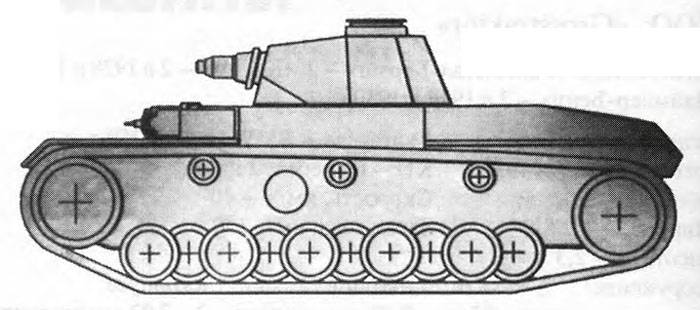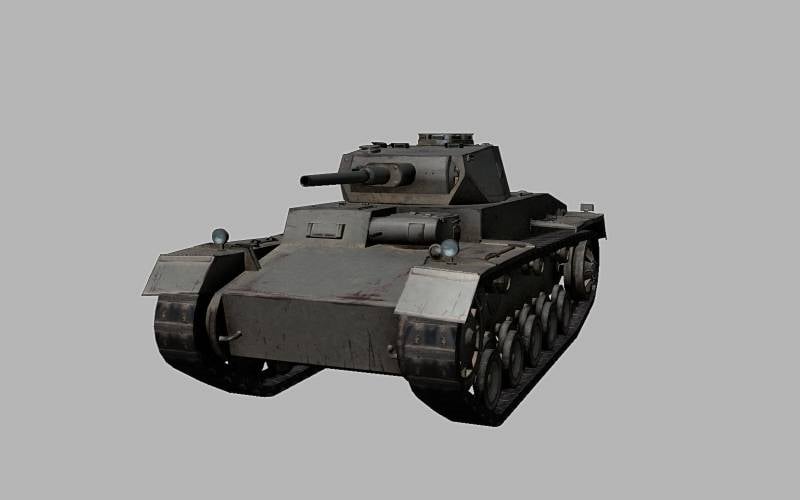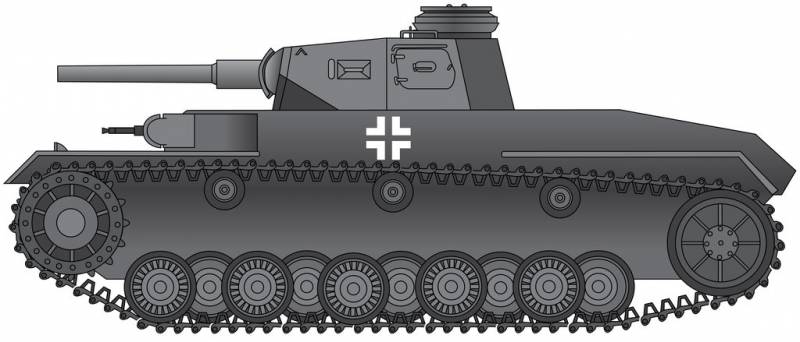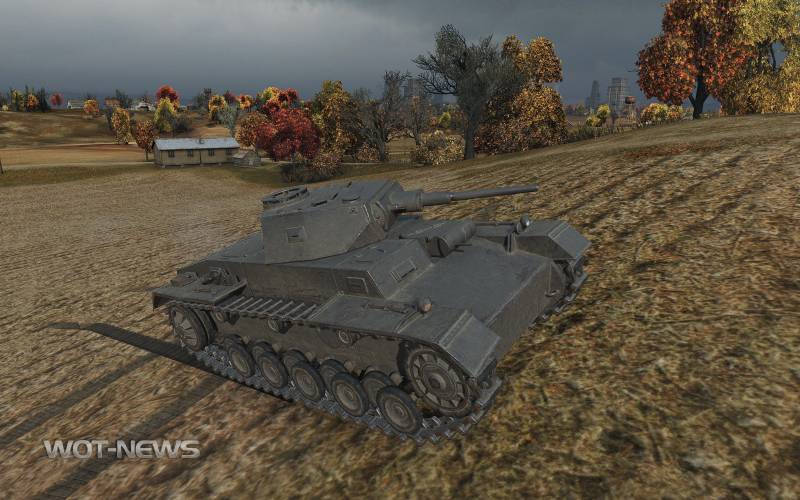Heavy tank Henschel VK 6501 (H), Germany
In September, 1939, the company Henschel received an order to develop a heavy tank with a combat mass of the order of 30 t, which was designated VK 3001 (H). Until the end of the year, the command, observing the development of a new project, came to the conclusion that it was necessary to create a new version of the heavy tank. VK 3001 (H) did not fully meet the existing requirements, which is why it was decided to order the development of an alternative project with different characteristics. It was proposed to change the requirements for protection, firepower and weights of the machine.
The alternative heavy tank had to have a reservation up to 80 mm thick, carry an 75-mm cannon and weigh up to 65 t. Calculations showed that with such a softening of requirements, the project authors would be much easier to solve the assigned tasks. In addition, despite the increase in total weight, the new tank could differ from existing and prospective armored vehicles and have certain advantages over it. According to the estimated combat mass, the project received the designation VK 6501 (H). In addition, the company-developer used the factory name of the project SW - according to various data, Schwerewagen (“Heavy Tank”) or Sturmwagen (“Assault Tank”).

Scheme of the tank VK 6501 (H). Figure Chamberlain P., Doyle H. "Complete Reference Book of German tanks and self-propelled guns of the Second World War"
For various reasons, it was decided to develop a new heavy tank based on existing developments in previous projects. At the same time, the ideas were supposed to be borrowed not only from the DW and VK 3001 (H) projects. One of the sources of technical solutions was to be the medium tank Pz.Kpfw.IV, shortly before it entered mass production. With certain reservations and from some points of view, the heavy tank VK 6501 (H) looked like an enlarged and reworked version of the Pz.Kpfw.IV.
New requirements for the protection of the tank, as well as proposals relating to the composition of weapons, led to the emergence of the original hull design with a powerful anti-drop armor. The front part of the machine was to consist of two main parts with a thickness of 80 mm. The bottom one was mounted at a certain angle to the vertical, and the top one was installed with a large inclination. Behind the upper frontal oblique body parts, it was proposed to install systems of unusual design. At the starboard, it was proposed to mount a wheelhouse with viewing devices for the driver. To her right was a small-diameter epaulet for installing an additional turret with machine-gun armament. The hull received an 80-mm bead and a smaller feed.
On the roof of the hull should have been located armored turret, the protection parameters of which were similar to the hull. The design of the tower was based on the developments of the Pz.Kpfw.IV project and on the developments of the Durchbruchswagen family, which led to the appearance of a characteristic appearance formed by several even panels of different shapes and sizes. The maximum thickness of the sheets of the tower reached 80 mm.
The hull of a heavy tank should have a standard layout for German armored vehicles. In front of the car, it was necessary to place the transmission units and the control compartment with an additional turret. The center of the corps was given under the fighting compartment with the main tower, and the feed contained a power plant. Preliminary study of the project showed that the operation of the 65-ton tank can be associated with serious difficulties. In particular, transportation problems were expected. Because of this, the original hull design was proposed, which is able to a certain extent to simplify the transfer of tank units.
The tank hull was divided into three main sections: the front one with the transmission and the control compartment, the central one with the combat compartment and the turret, and the aft one with the engine. If it was necessary to transfer tanks over a long distance, it was proposed to disassemble armored vehicles into three parts and load them onto suitable vehicles. After arriving in the desired area, armored vehicles should be assembled back, to connect all the onboard systems and to prepare for combat work.
In the stern of the VK 6501 (H) tank, it was proposed to install a Maybach HL 224 carburetor engine with an 600 horsepower. With the help of a cardan shaft, passing through the central part of the body, the engine had to be connected with the transmission of the front location. The manual transmission included a six-speed manual gearbox, final drives and brakes. This equipment was used to transmit torque to the front drive wheels.
The chassis of the SW tank was designed using the available groundwork. On each side of the tank, it was proposed to mount ten small-diameter road wheels equipped with an individual torsion bar suspension. The rollers were placed in a staggered manner, the outer row was shifted forward relative to the inner one. The drive wheels of the tracked propulsion unit were placed in the front of the hull, the guides in the stern. As in some other tanks of that time, the drive wheels were mounted with a significant excess above the supporting surface, and the guides were located below. There were three pairs of support rollers to hold the upper branch of the track in the normal position. A characteristic feature of the undercarriage was the use of a caterpillar with a width of 800 mm. Only the uniquely large track width compensated for the weight of the machine.
A curious feature of the hull and undercarriage of the new heavy tank was the design of the wings and fences. For some reason, probably because of the need to reduce the size of the machine in the transport state, it was decided to abandon the central sections of the shelves. The front block of the hull had a pair of wings and relatively short shelves, similar units were on the aft compartment. At the same time, the central fighting compartment had no external parts covering the track from above.
The main armament of the VK 6501 (H) tank was to be located in a relatively large tower on the roof of the hull. The tower was a further development of existing units with some modifications related to the protection and placement of internal equipment. Tower drives allowed to direct weapons in any direction horizontally. There were also systems for vertical guidance. Due to the large mass of the tower horizontal guidance should be carried out using a hydraulic drive.
The main weapons prospective tank was proposed to make a gun 7,5 cm KwK 37 with a barrel length 24 caliber. Because of the relatively short barrel, such a weapon could accelerate the projectile only up to speeds of the order of 450 m / s. When using an armor-piercing projectile, it was possible to penetrate 35 mm of homogeneous armor from a distance of 1 km. Cumulative ammunition, depending on their type, could penetrate protection up to 70-75 or up to 100 mm.
On one machine with a gun, an 7,92-mm MG 34 machine gun was to be placed. The second machine gun was proposed to be installed in a small turret in front of the hull. The design of this tower allowed to fire within a certain sector of the front hemisphere. The pickup angles were limited to the cutting of the driver on the right and the ergonomics of the control compartment on the left.
The crew of the new heavy tank was to consist of five people. In the right front of the case was placed the workplace of the driver. In the front and side sheets of his cabin there were viewing instruments for tracking the road. The cabin roof was equipped with a hatch for access inside the car. To the right of the driver was the shooter who ran the front tower. In the frontal part of his tower there were viewing devices and a sight, and the roof was equipped with a hatch.
The main tower of the tank was made triple, it was located gunner, commander and loader. The tower had hatches in the roof and in a small commander's cupola. In addition, existing hatches were borrowed from the existing medium tank. In the sides, as well as on the commander's turret, viewing instruments were placed, providing observation of the entire environment. If necessary, the fighting compartment could be left through round evacuation hatches in the sides of the hull, located between the support rollers and the upper branch of the track.
The increase in armor thickness and other required innovations have led to a significant increase in size and weight of the tank in comparison with other similar developments. The length of the vehicle reached 7 m (the gun barrel did not protrude outside the hull), width — 3,2 m, height — 2,92 m. with. per ton. This allowed the highway to reach speeds up to 65 km / h. Power reserve did not exceed 600 km.
According to customer requirements, the new tank had to overcome various obstacles, both land and water. In particular, he was able to cross shallow reservoirs to wade, but this was due to some problems. The collapsible architecture of the hull, which facilitated transportation, adversely affected the tightness of the structure. Because of this, even a small water barrier required a certain preparation of the machine with the inspection and seal of all the joints of the hull. The possibility of wading into water without these operations was virtually excluded.
The collapsible design of the hull required some related enterprises to be involved in additional work. Thus, the company Faun was ordered to develop a special truck equipped with a crane. Such a car was supposed to disassemble, transport and assemble combat vehicles.
The basis for the auxiliary machine has become a Faun L900D / 567 heavy-duty three-axle truck. On this chassis, a Demag LK-5S crane capable of lifting up to 20 tons as well as a platform for transporting individual elements of a heavy tank should have been installed. According to the calculations of the authors of two projects, for disassembling or assembling one SW-type machine, two special vehicles with cranes were required.
The development of a special semi-trailer with a payload of the order of 60 t was also initiated, with the help of which it was planned to transport tanks on the roads. The creation of such a machine was assigned to the company Karl Kassbohrer. In the future, this project led to the emergence of vehicles for serial tanks of new models.
VK project development 6501 (H) was launched at the end of 1939 of the year. Part of the next year was spent on developing the project. By the middle of spring, documentation was prepared, which allowed to start assembling a demonstration wooden model. This product and a set of drawings presented to the customer, after which he gave the nod to the assembly of experimental equipment. Due to the limited capabilities of the development company, it was decided to involve several related enterprises. The prototype of the SW / VK 6501 (H) tank was to be the result of joint work.
Approving the project, the army issued an order to the companies Krupp and Henschel. The first was to assemble a new tower with weapons, which should be used in the construction of the first prototype. In addition, it was necessary to prepare for the possible mass production of such products in the interests of the mass construction of heavy tanks. The task of the company Henschel was the assembly of an experienced chassis. In order to accelerate and reduce the cost of construction, the body of this machine was to be made of structural steel.
Due to the outbreak of war, industrial enterprises were loaded with current orders, which adversely affected the course of new projects. The program to create a heavy tank VK 6501 (H) was no exception. In the middle of autumn 1940, it turned out that Krupp had not yet assembled the required tower and could not start mass production of such products. After identifying this problem, it was decided to complete the construction of an experienced tank and release it for testing in its existing form, in an incomplete set.
Henschel also faced problems, which is why the prototype chassis of a heavy tank was prepared for testing only by the middle of the 1941 year. An armored vehicle without a tower and weapons was delivered to the test site. In this form, she had to show her abilities. Soon, industry and army experts conducted sea trials of this sample and made certain conclusions. In addition, there were plans to develop an existing project.
An experienced chassis could not show outstanding performance due to the large mass and insufficiently powerful engine. The mobility of the car left much to be desired, and after installing a sufficiently heavy tower, this parameter should have further deteriorated. Nevertheless, the customer represented by the army commission did not rule out the possibility of further development of the project with the subsequent commencement of construction of equipment for the army.
After testing, there was a proposal to refine the existing project to change the basic characteristics. Thus, it was proposed to replace the frontal parts of the hull with sheets of 100 mm thickness. Other modifications and assemblies of the combat vehicle should have undergone certain modifications. Work on upgrading the tank SW / VK 6501 (H) could start as soon as possible.
Nevertheless, it was decided to abandon the development of the existing project. His improvement required additional time, effort and money. In the presence of several alternative projects, further work on the VK 6501 (H) tank seemed inappropriate. Moreover, by the middle of 1941, the command had rejected several other developments in the field of heavy tanks, preferring other projects to them.
At the end of May 1941, the German command decided to stop work on the VK 3001 (H) project, the shortcomings of which at one time led to the beginning of the VK 6501 (H) creation. Instead, Henschel was to create a car with the symbol VK 3601 (H). Later this project “grew” into a heavy tank VK 4501 (H), which reached mass production under the name Pz.Kpfw.VI Tiger. Due to such changes in plans, the development of VK project 6501 (H) was discontinued by the fall of 1941.
The no longer needed prototype chassis of a heavy tank weighing 65 t was returned to the developer. For some time the machine was idle without work, after which it was disassembled for parts. Some elements of the chassis were probably used in the construction of other equipment, while others, in turn, went to the smelter. The exact dates for the disposal of the prototype have not been established, but it is known that these works were completed before the end of the war.
The aim of the VK 6501 (H) project was to develop a promising heavy tank, devoid of the shortcomings of existing machines. The main goal of this project was to increase reservations in the face of less stringent requirements for combat mass. Design tasks were successfully solved, but the finished machine did not suit the customer. In addition, by the time a new type of experienced tank appeared, several alternative variants of such equipment had been developed. As a result, the VK 6501 (H) / SW armored car was no longer needed, and the development of heavy tanks continued with the help of other projects.
Based on:
http://aviarmor.net/
http://pancerium.pl/
http://ftr.wot-news.com/
Chamberlain P., Doyle H. Complete reference book of German tanks and self-propelled guns of the Second World War. - M .: AST: Astrel, 2008.
Baryatinsky M.B. Heavy tank "Tigr" // Armored collection. 1998. No.6.



Information